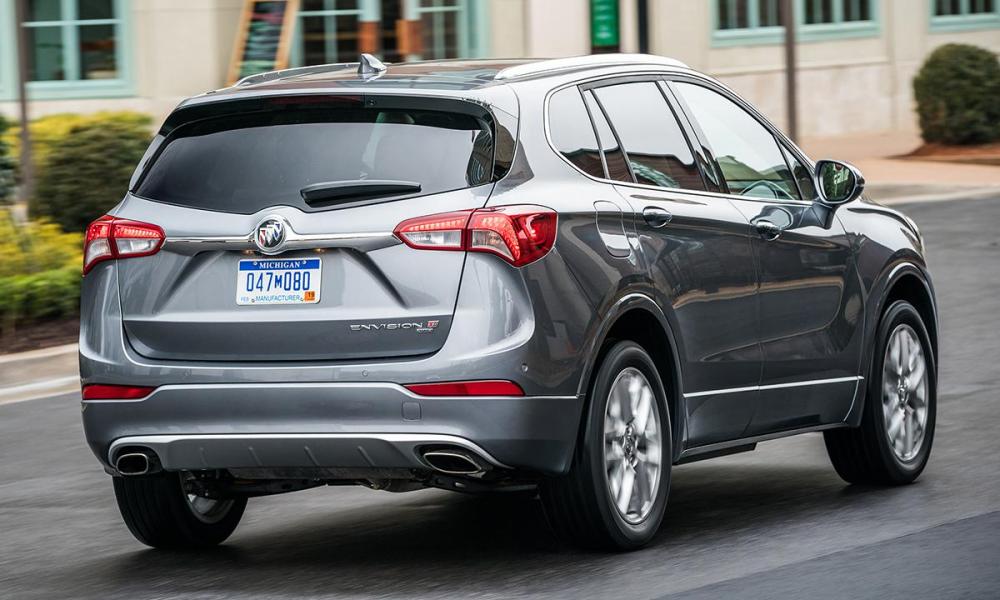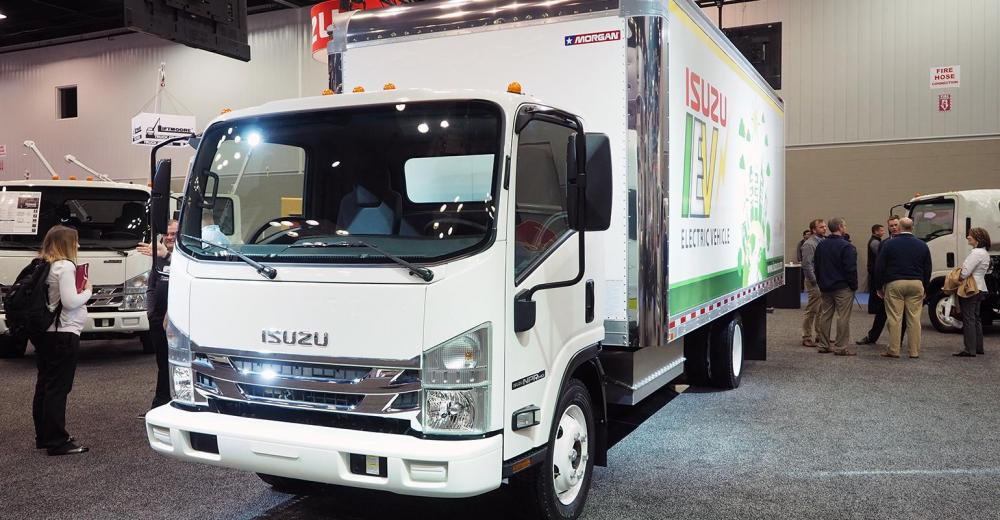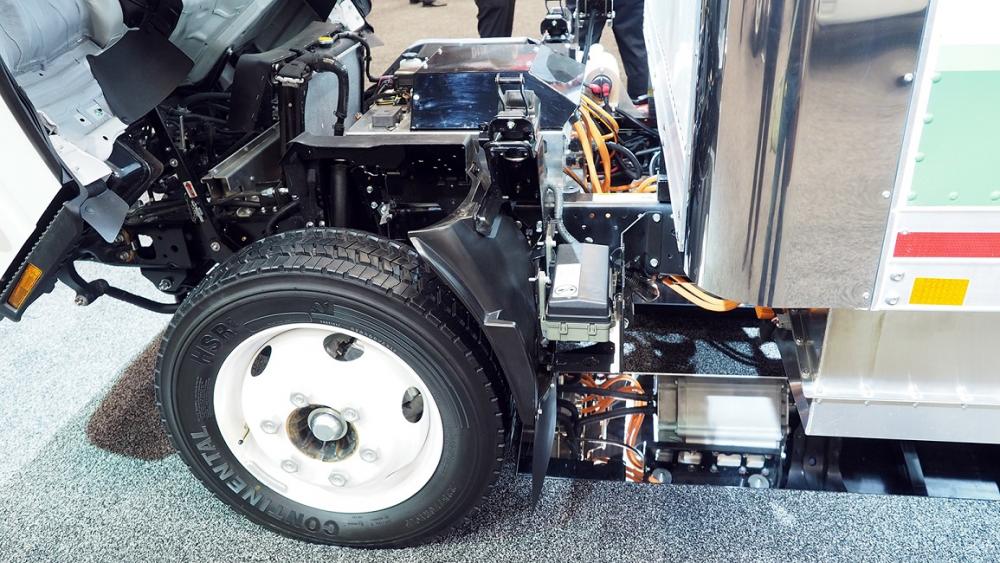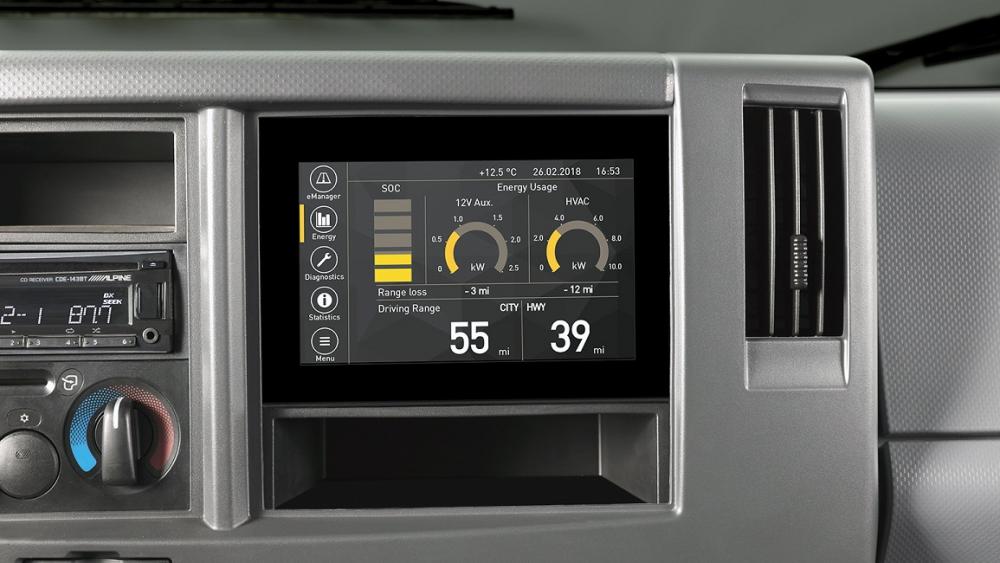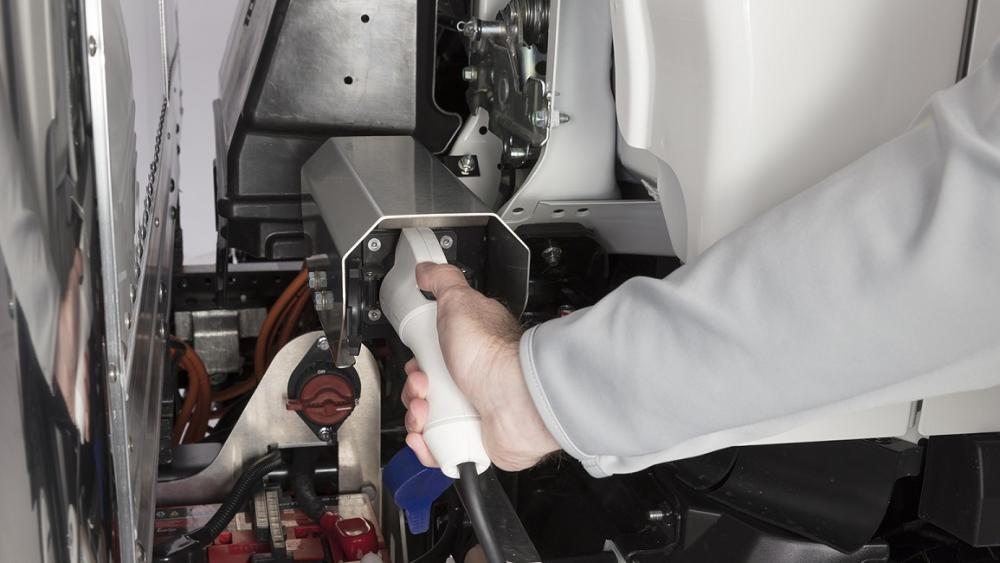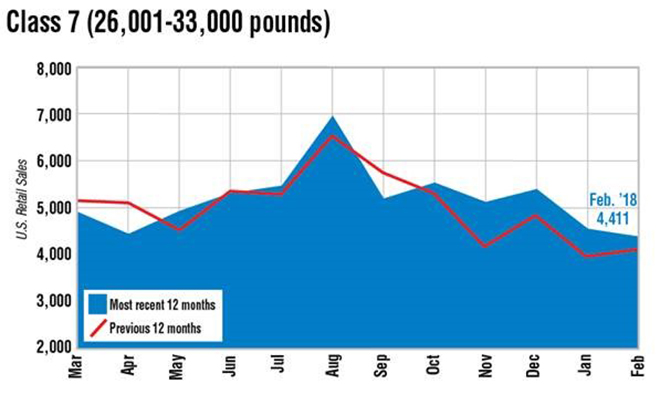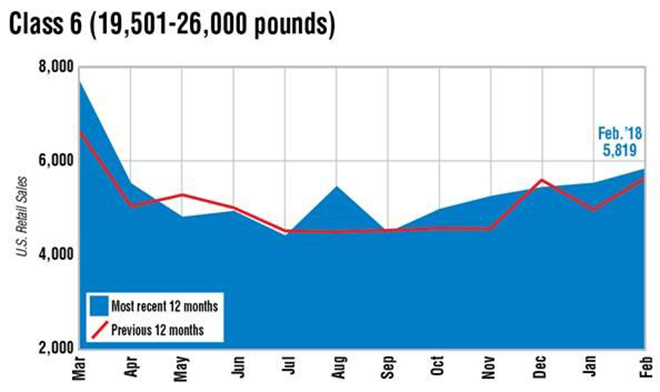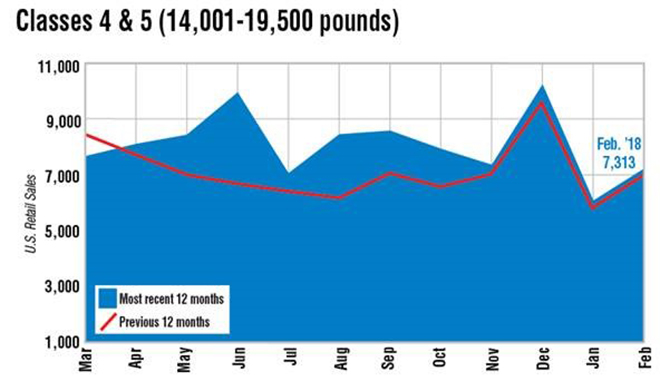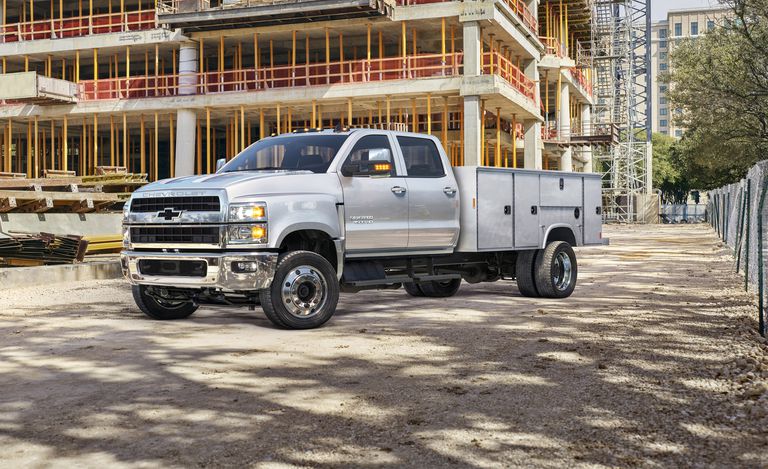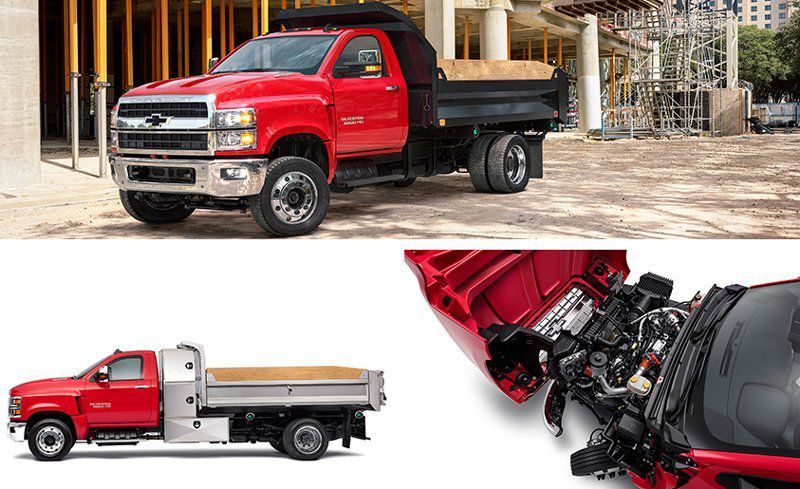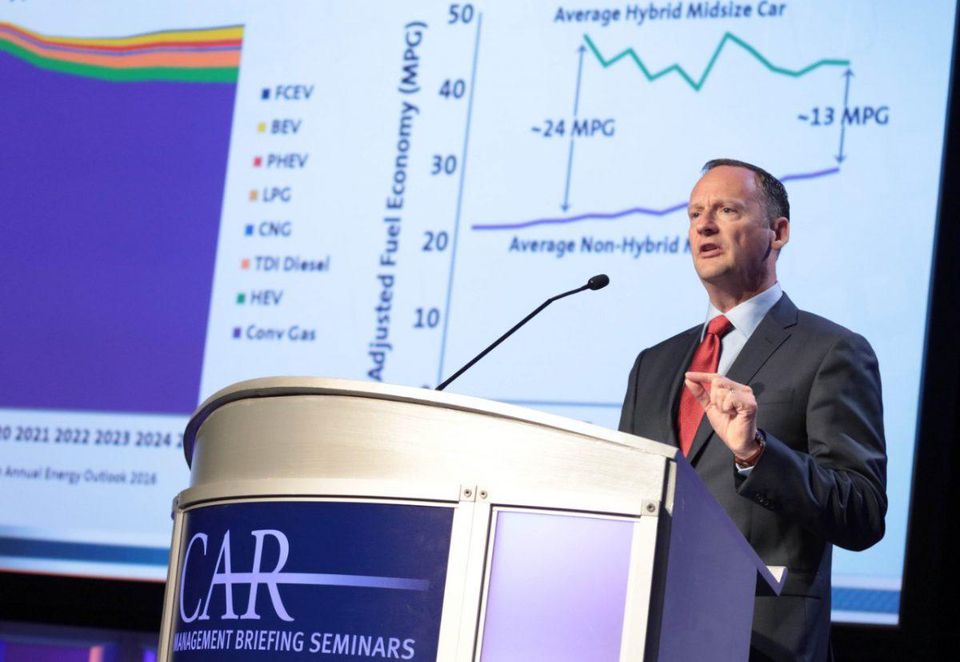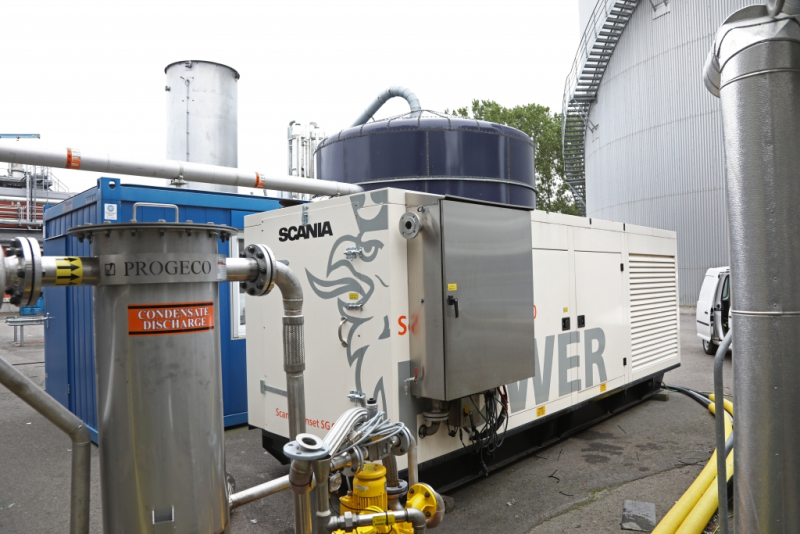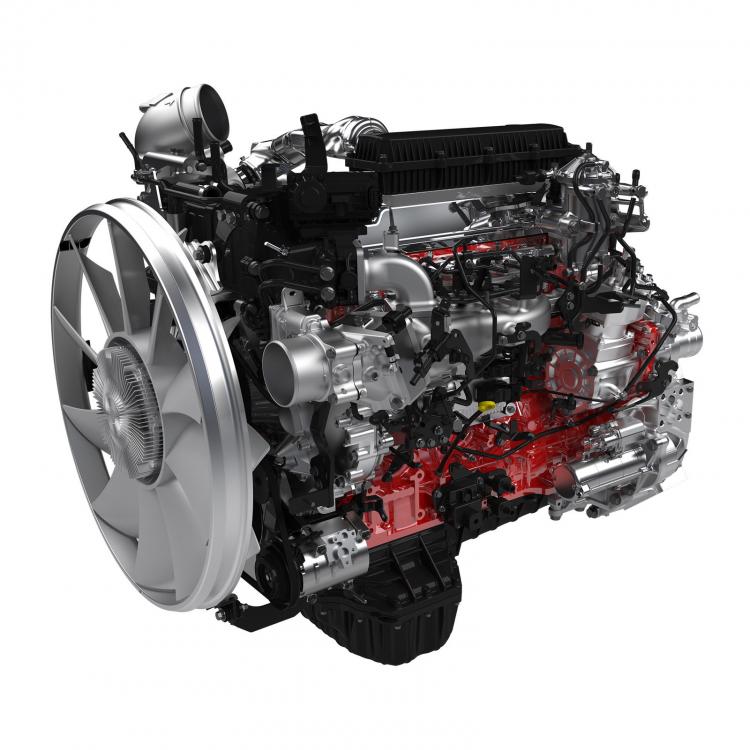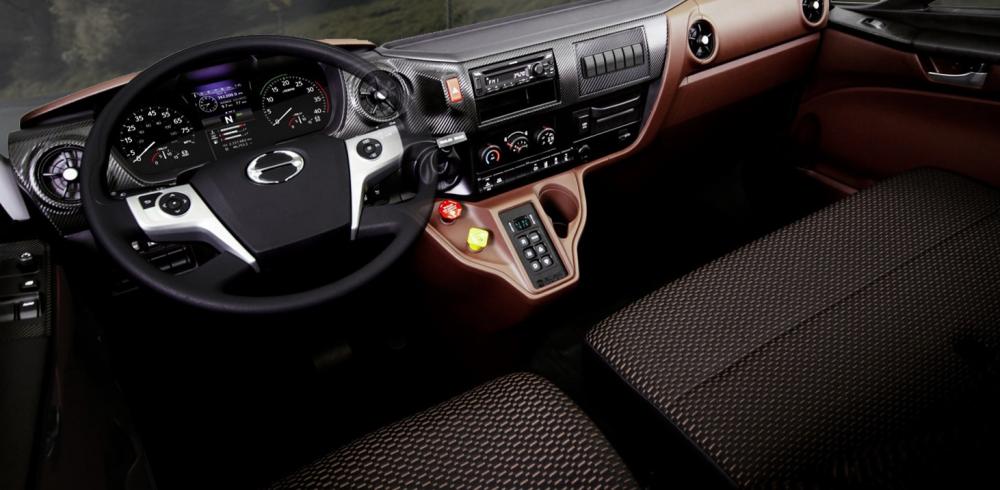
kscarbel2
Moderator-
Posts
18,885 -
Joined
-
Days Won
114
Content Type
Profiles
Forums
Gallery
Events
Blogs
BMT Wiki
Collections
Store
Everything posted by kscarbel2
-
Yes, that's a Buick — just without the 'Buick' name badge Jackie Charniga, Automotive News / March 13, 2018 DETROIT — Starting with the 2019 model year, Buick vehicles will no longer bear the name in North America. As each vehicle shifts in the next model year, the company said, the naming badge will disappear. Ditching the "Buick" script badge first was the 2019 Buick Envision. The badge was conspicuously absent during the premiere of the vehicle's midcycle refresh last month. "It was a small running change that we didn't view as especially worth announcing to the world, but I've been pretty amazed by the interest in it in the past couple days," Buick spokesman Stuart Fowle said. The main reason for dropping the script is consistency across marketplaces, according to Fowle. Since launching Buick in China, the only market outside of North America for the brand, the badge has been absent on those vehicles. But market research Buick conducted revealed that 3 out of 4 consumers recognize the tri-shield badge as Buick without seeing the name. "We are in the minority of brands that have their badge in addition to having their name on the back of the vehicle," Fowle said. "It was like we were saying Buick on the back of the car two times." Across the industry, Buick found name badges are disappearing more and more from vehicles. The exception, Buick found, is the pickup market, where the badges appear to get bigger and bigger in each model iteration. Another benefit of losing the Buick script is clearing space for the Avenir name. Buick's upscape subbrand is currently marked on the two front doors of the Enclave and the LaCrosse, though nothing today identifies Avenir from the rear, Fowle said. .
-
Florida teen killed 1, stabbed 2 others at sleepover because 'of his Muslim faith' WFTS-ABC News / March 13, 2018 PALM BEACH GARDENS, Fla. — A 17-year-old Florida teen has confessed to a deadly stabbing on Monday saying he did it because of his Muslim faith, according to Palm Beach Gardens police. Police say that a sleepover at a friend's house turned deadly when 17-year-old Corey Johnson secretly planned to kill his friend's mother, brother and brother's friend in their sleep. Johnson has since been charged with one count of murder and two counts of attempted murder. According to an arrest report, Johnson was sleeping over at 15-year-old Kyle Bancroft's house on Sunday night. Kyle's brother, 13-year-old Dane Bancroft, also had a friend sleeping over, 13-year-old Jovanni Brand. Kyle and Dane's mother, Elaine Simon, was at home watching the teens. Johnson said Brand was "idealizing famous people and referencing them as gods" which went against his faith, according to the arrest report. And he felt Dane "made fun of" his Muslim faith, the probable cause affidavit states. Johnson told police that he watched violent videos on the Internet and "was reading The Quaran from his phone just prior to the attack to give him courage to carry out his intentions," the probable cause affidavit states. "Our understanding is he had converted to Islam and had been watching violent videos online," said interim Palm Beach Gardens Police Chief Clint Shannon. When asked if the incident was linked to ISIS, Shannon replied, “Not from what we’ve uncovered, but we understand he has been watching violent videos, which may have some link to ISIS.” When authorities spoke to Kyle, he told them he knew that Johnson believes in the Muslim faith and although he (Kyle) doesn't believe in the faith, the two often watched videos about Muslim Jihadists together on the Internet. "The videos are extreme and encourage death to non-believers," the arrest report states. Johnson was a student at Dwyer High School and recently withdrawn. Johnson is being held at the Palm Beach County Juvenile Detention Center without bond. The FBI is now involved in the case. Following his arrest, Johnson told police that he bought a knife on Sunday and brought it to the sleepover. He said that around 4 a.m. on Monday, he realized that everyone in the house was asleep. That's when he said he made the decision to kill Simon, Dane and Brand. Johnson went to where Brand was sleeping in the loft located upstairs and stabbed him multiple times, then cut his throat. Around that time, Simon heard a commotion coming from upstairs and when she went to check on the boys, she was met at the stairs by Johnson who stabbed her multiple times. She says that Dane ran to protect her and was also stabbed multiple times. The two were able to escape to a neighbor who called 911. Officers who responded to the scene found Johnson barricaded in a bedroom, and later found Brand in an upstairs bedroom with multiple stab wounds and a throat laceration. He was pronounced dead at the scene. Police say that Kyle was unharmed during the incident, his mother was stabbed 12 times, and his younger brother Dane was stabbed 32 times. Simon told police that she has known Johnson for over 10 years. Following Johnson's arrest, he told police that he stabbed the victims "because of his Muslim faith."
-
Communist Party-backed Geely wants major Daimler stake
kscarbel2 replied to kscarbel2's topic in Trucking News
Backlash grows over Chinese deals for Germany’s corporate jewels The Financial Times / March 13, 2018 Geely’s investment in Daimler crystallises fears about a loss of engineering knowhow and expertise When Geely announced last month that it had acquired close to 10 per cent of the shares in Daimler, owner of Mercedes-Benz, the gasps of shock in Berlin were almost audible. Politicians and commentators were in uproar. MPs wanted to know how the Chinese carmaker had managed to inveigle itself into a German industrial icon. “What’s disturbing is the way Geely just crept up on Daimler out of nowhere,” says MP Kerstin Andreae, the Greens’ expert on economic policy. “One fine day Daimler’s CEO [Dieter Zetsche] woke up to find he had a new principal shareholder, and that’s a huge change in the company’s ownership structure.” The latest in a series of controversial forays into German industry and financial services, the deal crystallised longstanding fears about Chinese intentions. The way some in Germany see it, China is on a mission to suck the country dry of its technological know-how and engineering expertise, and supplant it as one of the world’s leading industrial powers. It is, from Germany’s perspective, a process that is driven and directed by the Chinese government. Even purely private investments like Geely’s in Daimler are suspect. “The fear is that the state is somehow behind this deal, that geopolitical as well as economic interests are tied up in it,” says one senior German official. Geely chairman Li Shufu insists he is a private entrepreneur with no ties to the authorities. Speaking to German tabloid Bild am Sonntag earlier this month, he said he had not taken a “single cent” from Beijing to buy the Daimler shares. And his intention was not to siphon off German technology, but to co-operate on electric and self-driving cars so the two companies could better fend off Silicon Valley disrupters such as Elon Musk. “We can’t just abandon the field to him,” he said. Yet to Chinese state media he conveyed a somewhat different message. Speaking to CCTV, he said the investment was designed to “support the growth of the Chinese auto industry” and “serve our national strategies”. Reports that Geely was eyeing Daimler’s battery technology for electric cars — the company’s crown jewel — only heightened the sense of alarm in Berlin. Indeed, the concern in Germany is that Mr Li’s Daimler deal is all of a piece with Made in China 2025, President Xi Jinping’s 10-year plan to transform the country from a low-cost manufacturer into a high-tech power dominant in 10 advanced industries, including electric vehicles. It is a strategy that Germany sees as a direct threat to its commanding position in the car industry. “If Made in China 2025 succeeds, German industry might as well just pack up and go home,” says Thorsten Benner, director of the Global Public Policy Institute in Berlin. Germany is not the only country to see a backlash against Chinese acquisitions. In the US, a bill working its way through congress would significantly increase scrutiny of inbound investment, particularly in “critical” technologies such as artificial intelligence or robotics that are part of the Made in China 2025 strategy. But the anxiety is particularly acute in Germany. It specialises in precisely the area that Chinese companies are looking to move into as their labour costs rise — high-end manufacturing. The disquiet in German boardrooms has coincided with a huge shift in the political elite’s thinking on China. “You increasingly have the feeling that Germany and China are moving from being partners, to rivals, to adversaries,” says Dirk Schmidt, an expert on Chinese foreign policy at the University of Trier. “The change in mood is astonishing, considering how quickly it’s happened.” The Geely kerfuffle is only the latest example of a Chinese investment making waves in Germany. The most controversial was Chinese appliance maker Midea’s €4.5bn acquisition of Kuka, Germany’s largest maker of industrial robots, in 2016. Then in February last year, Chinese conglomerate HNA Group snapped up a 3 per cent stake in Deutsche Bank, which it later raised to 9.9 per cent — becoming the bank’s largest shareholder. The forays triggered a backlash. After the Kuka deal Berlin abruptly withdrew its clearance for Fujian Grand Chip Investment’s takeover of German chip equipment maker Aixtron. The company later dropped its bid after the administration of then US President Barack Obama stopped the deal on national security grounds because of Aixtron’s American subsidiaries. Then last year Berlin tightened its law on overseas investment, enhancing ministers’ powers to block foreign acquisitions of 25 per cent or more of companies operating in “critical infrastructure”. The change also gave the government longer to investigate takeovers, expanding the timeframe from two to four months. That sent out an important signal, says Björn Conrad, head of the China-focused consultancy Sinolytics. “Four months can be an eternity for an M&A deal,” he says. “It means a longer period of uncertainty.” Germany’s protectionist drive moved up a gear a year ago when it teamed up with France and Italy on a joint initiative to introduce more rigorous screening of foreign takeovers of EU companies, especially those with suspected state backing. The move could be the first step towards an EU-wide mechanism similar to Washington’s powerful Committee on Foreign Investment in the United States, or Cfius. The backlash has in part been fuelled by anger at what is seen as a lack of reciprocity in dealings between China and Germany. “It’s irritating how little China has implemented the principle of openness, which it rightly demands from other states, in its own backyard,” says Dieter Kempf, head of the BDI, Germany’s main business organisation. Berlin’s new coolness towards Chinese investment has led to a marked drop-off in deal activity. China itself has contributed with a regulatory clampdown on outbound deals, amid fears that the foreign acquisitions were draining the country’s foreign exchange reserves. HNA is one of a number of Chinese groups which are now under pressure to sell overseas assets: last month it revealed it had cut its stake in Deutsche Bank to 9.2 per cent. Yet the Geely deal bucked that trend, and revived fears of Chinese encroachment. “The public reaction was huge because Daimler is the German economy, even more so than Deutsche Bank,” says another German official. Mr Li also raised eyebrows by building up his $9bn stake in a way that allowed him to circumvent strict German disclosure rules. Normally investors must tell the authorities if their share of voting rights exceeds 3 per cent. Geely got around that with a clever combination of derivatives, bank financing and share options. Some German politicians felt Daimler and BaFin, the country’s financial regulator, had been tricked. “The whole operation looks very engineered,” says Hans Michelbach, an MP and finance expert from Chancellor Angela Merkel’s CDU/CSU bloc. Geely had apparently “exploited legislative grey areas” to sidestep the law, he says. Ms Merkel herself said there could be legal “loopholes” that needed to be closed. Some politicians worried about a potential conflict of interests: the Geely holding company also owns a minority stake in Volvo Group, which competes with Daimler’s heavy trucks division. Brigitte Zypries, economics minister, says Mr Li could now claim a seat on Daimler’s supervisory board: “If competitors are represented [there], then that’s a problem.” Mr Li told Bild that a Daimler board seat was “not a priority” for him, and has said he has no plans to increase his stake — “for the moment”. German mistrust of China’s economic motives is part of a broader cooling in the Berlin-Beijing relationship. Worries about the Chinese corporate advance are merging with concern about the growing centralisation of power and more assertive foreign policy under Mr Xi, a trend that was underscored by the Communist party’s move to scrap presidential term limits this week. The number of irritants is multiplying. Late last year, Germany’s internal security service revealed that Chinese intelligence agencies were setting up fake profiles on social networks such as LinkedIn to establish contact with — and potentially recruit — German politicians and officials. Berlin is also worried about China’s leadership of the “16+1” group, which embraces 16 central and eastern European countries, 11 of them members of the EU. “The impression is gaining ground that China is succeeding in splitting Europe,” says Mr Schmidt. “It’s getting harder to co-ordinate common positions on things like human rights.” Ms Merkel addressed the issue last month during a press conference with Zoran Zaev, the prime minister of Macedonia. Was China using the 16+1 group to influence Balkan states, a reporter asked her. “The question is: are economic relations being linked with political issues?” she said. If they were, this would not be in the “spirit of free trade”. Linked to that, Germany is highly suspicious of China’s Belt and Road Initiative, one of Mr Xi’s signature projects. It is worried that European countries, perhaps even a big EU economy such as Italy, will cave in to Chinese pressure to sign a bilateral memorandum of understanding supporting the project, which aims to finance and build infrastructure in about 70 countries in Eurasia, the Middle East and Africa. At the Munich Security Conference last month, Sigmar Gabriel, the German foreign minister, long seen as a hawk on China, warned that the initiative was “no sentimental evocation of Marco Polo”, but “an attempt to establish a comprehensive system for moulding the world in Chinese interests”. China is the only country “with a truly global, geostrategic idea”, he said. The west, Mr Gabriel added, had no strategy of its own to offer in response. Back in Berlin, authorities are still wrestling with how to respond to Geely’s investment in Daimler. Officials are angry at being blindsided but conscious that they lack the tools to intervene. Some MPs talk of changing the foreign investment law again: currently, deals can only be blocked if non-EU companies try to acquire more than 25 per cent of a German entity. That has left the government powerless to become involved in another controversial transaction: State Grid of China Corp’s attempt to buy a 20 per cent stake in 50 Hertz, a German electricity grid operator. “My view is that the 25 per cent threshold is not working,” said deputy economics minister Matthias Machnig last week. “It has to be changed.” Meanwhile, in some quarters there is resignation. Chinese influence in the global economy is growing, and no company, not even household names such as Daimler, is immune. “There’s a legitimate argument that Daimler will ultimately [only] survive by becoming a little less German and a little more Chinese,” says one German official. Authorities in Berlin say they will continue to keep a close eye on Geely’s actions at Daimler. “If it was really a corporate decision, then that’s fine,” says the senior official. “But with China, you never know.” --------------------------------------------------------------------------------------------- Investing in China: German businesses bemoan party role and data laws China is Germany’s largest trading partner, with imports and exports between the two reaching €187bn last year. Some 6,000 German companies are now active in China, which has received a total of €60bn in direct investment from Germany. For Daimler, the Chinese market is critical. It sells more S-Class Mercedes-Benz models in China than anywhere else and its largest production facility is in China. Last month the company had to issue a grovelling apology for posting an inspirational quote from the Dalai Lama on its Instagram account. But German business organisations complain that the environment for foreign groups operating in China is deteriorating. Dieter Kempf, head of the BDI business lobby, spoke out in January against the “Communist party’s increasing influence” on companies. “International investors should have the last word on business and investment decisions, not the party,” he said. At issue is Beijing’s demand that internal Communist party cells in joint ventures of foreign companies and state-owned Chinese entities be given an explicit role in decision-making, including investment plans. For the Mittelstand — the small and medium-sized enterprises that are the backbone of the German economy — “this sets all the warning lights flashing,” says Hubert Lienhard, head of the Asia-Pacific Committee of German Business, a trade body. “That’s the holy of holies for any company — how I deploy my own capital.” Another big worry is China’s cyber security law, which gives the government legal controls over the encryption and flow of data. The law “poses the risk of involuntary technology transfers and the loss of intellectual property rights, says Hanna Müller, the BDI’s top representative in Beijing. “You have to disclose a lot of data, and there is the risk that commercial secrets are just no longer protected.” -
Volkswagen ordered to rehire employee suspected of trying to join ISIS RT / March 13, 2018 A German court has ruled that Volkswagen should reinstate an employee that was fired on suspicion of terrorism-related activities. The company failed to prove that he poses a genuine threat. “The mere suspicion that [a person] belongs to a radical ‘Jihad movement’ as well as a preventive confiscation of an international passport resulting from it do not provide a sufficient reason for the termination of employment,” a regional labor court in the state of Lower Saxony ruled on Monday. The person in question is a German citizen of Algerian descent, identified only as Samir B. He worked as an assembly worker at one of the Volkswagen plants in the city of Wolfsburg, located around 90 km (55.9 miles) east of Hannover. In December 2014, he was detained at Hannover airport as he was trying to fly to Istanbul. Police found more than €9,000 ($ 11,155) in cash and a drone in his bag. He was suspected of making an attempt to travel to Syria and Iraq to join the Islamic State (IS, formerly ISIS). The Wolfsburg city authorities then confiscated his international passport. Samir B. attempted to appeal that decision but a German court ruled in 2016 that the travel ban was justified. The court also said the man was a member of a local radical Islamist group and had contacts with “numerous people who had joined… Islamic State.” Following the court’s decision, Volkswagen dismissed the assembly worker, arguing that he posed a threat to the company’s “peace and security.” Samir also appealed this decision, however. According to the German daily Bild, Samir B. had close contact with two other radicals, who subsequently left Germany for Syria, where they joined IS but were later killed. He was also in communication with an IS recruiter and two other extremists who have since been imprisoned in Germany after returning from the Middle East. Volkswagen’s lawyers argued that the man issued threats against his colleagues, reportedly telling them they “will all die.” They also told the court that they believed he could potentially stage a terrorist attack at the plant. All these facts appeared to carry insufficient weight for the Lower Saxony court, however, which deemed his dismissal invalid. The court said that Volkswagen failed to provide any valid evidence of misconduct or any proof that the man could put the security of the plant in jeopardy. They have a month to rehire him. Following the court decision, Volkswagen said it, “continues to believe that the dismissal was justified.” The company added that it would consider appealing the ruling in the federal labor court after examining the decision, as reported by the Stern daily. In the meantime, Samir’s lawyer, Hans-Eberhard Schultz, denounced his client’s dismissal as a manifestation of “institutional racism.” Volkswagen decided to fire the man “because he is a radical Salafist,” the lawyer told NDR, adding that such attitude poses a “big problem.” Salafists follow an ultra-conservative, fundamentalist interpretation of Islam, and Salafist organizations such as Hizb ut-Tahrir seek to live under Sharia law, perceiving Western-style democracy as incompatible with obeying God. Their beliefs are often regarded as the spiritual basis for groups like Al-Qaeda and IS. German authorities have repeatedly expressed concerns over the steadily growing number of Islamist radicals living in Germany. In January 2018, a report by the German domestic intelligence service, the BfV, said that the number of Islamists in Berlin has more than doubled since 2011. In late 2017, the head of the BfV, Hans-Georg Maassen, warned that there is now a record number of Islamists in Germany, putting their number at roughly 11,000.
-
Aaron Marsh, Fleet Owner / March 13, 2018 Beginning with an electrified Class 4 NPR-HD, Isuzu's group of battery electric cab-over trucks could make it into customers' hands later this year for fleet demonstrations. While Isuzu Commercial Truck of America has noted that its forte is medium-duty trucks running 4-cyl. turbo diesels, the company rolled out an all-electric truck at the 2018 Work Truck Show that was headed straight for testing after the event. Fleet Owner caught up with Isuzu's Brian Tabel, executive director of marketing, to hear more. "We're putting together a group of five of these, and we'll be evaluating, testing and monitoring them," Tabel said. "Hopefully in Q3 of this year, we'll be putting all five of them in customers' hands for real-world demonstrations to get feedback about what's working, what's not working, and how we can progress and monitor for the future as we look at developing this product for the U.S. market." This first group of Isuzu's battery-electric trucks will be based on the Class 4 NPR-HD, which has a gross vehicle weight rating of 14,500 lbs. Isuzu turned to Nordresa, a developer and manufacturer of commercial electric powertrains in Québec, Canada, to modify the N-Series truck with electric motivation. The electric NPR-HD on display was quite young — it was finished just a few weeks ago — but nonetheless sported graphics and had a well-finished look. Tabel explained that it will be tested in a number of ways and environments including weight, load capabilities, charge times, and distances possible under various loads in a range of weather and temperature conditions. "We'll be evaluating everything," Tabel said. "These vehicles will be around the country in different environments so we can get a true evaluation of the differences in how an electric vehicle is going to operate in cold weather, for example, vs. a hot, humid climate in Florida." Climate and temperature variations can have a big effect on electric vehicles and their capabilities. Tabel pointed out how his own hybrid-electric passenger car shows a notable difference with heavier power drains like running the heat and electrically heated seats, for example, which effectively siphon power away from the electric motor. As far as what duty cycles Isuzu thinks the electric trucks will be good for, it's likely to be things like pickup and delivery and use in urban environments. "That's really where you're going to excel with an electric vehicle," Tabel contended. But Isuzu acknowledges that electric trucks are a certain part of the future, he added, just as electric vehicles have already made inroads in the passenger car market. "There's definitely some big customers out there that are requesting it," Tabel noted of electric trucks. "They're big fleet customers looking five, 10, 15 years down the road at how their fleets are going to work. "They're definitely looking at this technology and saying that this is the direction that they want to go," he continued. Meanwhile, regarding other alternate fuels, Isuzu now offers the Class 3 NPR Gas and Class 4 NPR-HD Gas with General Motors' 6.0L Vortec V8 gasoline engine that can be prepped to run on liquefied petroleum gas (LPG) or compressed natural gas (CNG). "It's an abundant resource for us," Tabel said regarding natural gas in North America. "As fuel prices are so low, I don't think there's as much of that desire or need that people want to move to different fuels," he added, "but if fuel prices increase, the demand for alternative fuels will increase again." Thus, the business demand for alternative fuels must be there to drive product development, but that's not all. For fleets especially, electric or alternative fuel vehicles need access to charging or fuel supply. "The infrastructure is the other thing that needs to be there," Tabel said. "There are a lot of places that don't have a CNG station near them, for example. But as the infrastructure improves and people have more fuel options, I think you'll see that trend where things will turn back to interest in things like CNG." .
-
Mitsubishi Fuso's Class 4 Gasoline Cabovers Arrive
kscarbel2 replied to kscarbel2's topic in Trucking News
Fuso adds gas-powered Class 4 and 5 trucks to its lineup Josh Fisher, Fleet Owner / March 13, 2018 Adding to its diesel and electric FE trucks, Mitsubishi Fuso will manufacture new gas trucks in South Carolina. INDIANAPOLIS. Mitsubishi Fuso Truck of America introduced its new gasoline-powered Class 4 and Class 5 FE Series cabover work trucks to go with its diesel and electric-powered FE trucks. The third powertrain option gives the OEM the broadest option among medium-duty trucks today. The new gas-powered trucks feature a GM 6.0L V8 engine and Allison 1000 automatic transmission. The company is touting its new cab interior that it says is designed to improve driver comfort and efficiency and will also find a home in the FE diesel models. The V8 gasoline engine will be initially available in two Fuso Class 4 models — the FE140 (14,500 lb. GVWR) and FE160 (15,995 lb. GVWR). It will soon be available in Fuso’s Class 5 FE180 (17,995 lb. GVWR) model, making it the first Class 5 cabover with an available gasoline-fueled engine. In all models, the PSI-GM V8 engine provides 297 HP and 361 lb-ft of torque. It has a broad torque curve and engine management calibration developed specifically to integrate seamlessly into FUSO’s FE models using the Allison 1000 transmission. In future models, the engine could be equipped to use compressed natural gas (CNG) or liquefied petroleum gas (LPG) as fuels, for those fleets looking to reduce their emissions footprint. “The truck demonstrates our ability to leverage the resources of our parent company Daimler,” Bill Lyons, Fuso’s vice president of sales operations, said at the Work Truck Show last week. “The entire project is a collaborative effort between Fuso and Freightliner Custom Chassis Corp. These will be the first Fuso vehicles assembled in the United States in Gaffney, SC. The truck will be produced using engines and transmissions built in the United States and chassis and cabs sourced from both Fuso in Europe and Japan.” The gasoline models, while not priced yet, will be several thousand dollars cheaper than their diesel counterparts, according to Lyons. The Class 4 trucks will be available later this year; the Class 5 trucks will start production in 2019. Along with the new V8 gasoline engine, the new Fusos are equiped with the Allison 1000 heavy-duty automatic transmission, which makes FUSO the first cabover manufacturer to offer a commercial truck transmission in a medium-duty cabover, according to Lyons. The Allison transmission was designed from the ground up for use in commercial trucks, according to the OEM, and includes a provision for an optional power take-off (PTO) that can drive a wide range of vocational-truck accessories, like lift bodies or dispensing pumps. The Allison transmission also takes advantage of Allison-exclusive Fuel Sense 2.0 transmission management software—with DynActive shifting technology. Instead of shifting gears based on a data table of fixed shift points, DynActive technology continually refines shifts via a proprietary learning algorithm, to provide a balance between performance and fuel economy for each operator’s specific duty cycle. The results yield a 2% to 6% improvement in fuel economy. In addition, Fuel Sense 2.0 management provides a “Neutral-at-Stop” feature that further reduces fuel consumption. To provide increased operating range and fewer fuel stops per shift, the new Fuso FE Gas models also include a 40-gallon, rear-mounted fuel tank, complemented by streamlined fuel line and wiring harness routing and securement. The latter improve serviceability for the lifetime of the truck while protecting sensitive fuel and wiring lines from rubbing and chafing damage, for enhanced durability and reliability. The clean frame rails that result also provide additional space for toolboxes and side-mounted vocational equipment. “We’re extremely happy to be able to offer these new gasoline-powered trucks to our customers,” said Justin Palmer, Fuso’s president and CEO. “While much of the medium-duty market still relies on diesel power, gasoline engines are increasing in popularity, and now occupy about a 40% market share, so development of a gas-engine option for our customers was a no-brainer... “We’re also proud of the fact that, by adding our new gas-engine line to our existing diesel FEs and eCanter all-electric trucks, our dealers can offer their customers the broadest range of powertrain choices in the marketplace,” Palmer said. “No other truck manufacturer, in any GVWR class, currently offers all three of these powertrain options.” Cab Enhancements In addition to the new powertrain, the FE Gas trucks will introduce a new cab interior design. Most notably, the driver seat bolstering and support is improved to provide all-day comfort, the seat cushion covering has been extended for durability, and the seatbelts are now high-visibility Fuso red. The instrument cluster colors were revised to improve visibility under all lighting conditions, and an LED cabin light has been added. Storage space, too, has been enhanced, with a new driver-side overhead console, floor tray and sun-visor pocket. Finally, for aesthetics, a new black-on-black color scheme has been implemented marked by silver trim accents throughout the cab interior, including the stereo frame, the shifter panel and the steering wheel emblem. All of the cab improvements noted above will be transferred to the FUSO FE Series diesel models, as well. “Our new Class 4 FE140 GAS and FE160 GAS models will be on dealer lots by the middle of this year,” Palmer said. “With this great addition to our line, we look forward to a very successful year in the medium-duty market.” -
Transport Topics / March 13, 2018 U.S. retail sales of medium-duty trucks inched up in a normally flat month, clearing 17,000 units in February, WardsAuto.com reported. Sales in Classes 4-7 were 17,543, up 4.6% compared with 16,768 a year earlier. Year-to-date, sales rose 7.1% to 33,789, according to Ward’s. Sales mirror the economy, which is operating better than it was last year at this time, one analyst said. “In general, the economy is better off. We have this lingering psychological [post-election] bump that got a punctuation mark with tax reform finally getting passed. I think we are seeing early fruits of that [tax reform] with investment in equipment, especially by small businesses,” he said. The analyst suggested truck lease/rental companies could be buying earlier than usual to meet demand by businesses that need trucks to get work done but don’t want the commitment of a purchase. “It just kind of snowballs,” he added. One truck rental company agreed that something good is going on with the economy. “As we look at our Penske Truck Leasing business, our rental is really off the charts, we have never seen January come through like it has been,” Penske Automotive Group Inc. Chairman and CEO Roger Penske said on a Feb. 8 earnings call. Penske Truck Leasing Co. provides full-service truck leasing, truck rental, contract maintenance and logistics services. In February, sales of Class 7 trucks jumped the most, rising 7.8% to 4,411. Freightliner, a unit of Daimler Trucks North America, held a 51% market share in Class 7 with 2,262 sales. Combined sales by Paccar Inc.’s two truck brands rose 40% year-over-year to 902 Class 7 units. Paccar is the parent company of Peterbilt Motors Co. and Kenworth Truck Co. Class 6 volume rose 3% to 5,819 compared with a year earlier, and was led by sales at Freightliner, International and Ford. Isuzu Commercial Truck of America Inc. announced that production of its new entry in the Class 6 segment, the 2018 Isuzu FTR, will begin in May. The truck is powered by the Isuzu 4HK1-TC 5.2-liter turbocharged 4-cylinder diesel engine. The company sold 77 Class 6 trucks in February, or 6% of its Classes 4-7 volume of 1,282. Sales for Classes 4-5 rose 4.1% to 7,313 — led by Ford in Class 5 and Isuzu in Class 4. .
-
Heavy Duty Trucking (HDT) / March 12, 2018 Dana Inc. has signed an agreement to merge with the Driveline division of UK-based automotive system supplier GKN plc to create Dana plc, a global provider of driveline systems, in a move that will position it for the vehicle electrification market. GKN Driveline is based in the United Kingdom and produces constant-velocity jointed driveshafts, all-wheel-drive systems, and electrified driveline solutions. The transaction also includes GKN's Off-Highway Powertrain Services business, which serves the off-highway power delivery and service market. GKN Driveline has around 35,000 employees globally with operations in 23 countries and has 61 manufacturing locations, including one of the largest driveline businesses in China via its joint venture, Shanghai GKN Huayu Driveline Systems (known as SDS). With sales of around $13.4 billion, the new company will become a global leader in vehicle drive systems across light vehicle, commercial, and off-highway markets. Dana plc will also be well-positioned for the vehicle electrification market with its core eDrive technology portfolio, according to the company. The deal also solidifies Dana’s presence in key markets, such as China. "This transformative and strategic transaction solidifies Dana as a world leader in vehicle drive systems and establishes a leading position in electric propulsion, which we see as the future of vehicle drivetrains," said James Kamsickas, president and CEO of Dana. The combined company will be based in the United Kingdom as Dana plc and will continue to trade on the New York Stock Exchange under the ticker symbol DAN. The deal includes $1.6 billion in cash proceeds to GKN plc, the assumption of approximately $1 billion of net pension liabilities, and 133 million new Dana plc shares issued to GKN's shareholders, valued at approximately $3.5 billion (based on Dana's share price as of March 8, 2018). Under terms of the agreements, Dana shareholders will own approximately 52.75% of the company with GKN shareholders owning 47.25%. "We believe this transaction will result in a much stronger Dana, both strategically and financially, by taking advantage of the combined company's global scale, technology leadership, strong balance sheet, and attractive cash flow profile," said Jonathan Collins, executive vice president and chief financial officer of Dana. "In the near term, we expect our business to achieve best-in-class returns on capital and continue on the path to an investment grade credit profile." Dana expects to complete the transaction, which is subject to shareholder and customary regulatory approvals, in the second half of 2018.
-
Hyliion Offers Week-Long Tests of its Hybrid Tractors
kscarbel2 replied to kscarbel2's topic in Trucking News
Hyliion HE drive axle wins Technical Achievement Award Truck News / March 12, 2018 ATLANTA, Ga. — A powered auxiliary axle for road tractors from Hyliion, a recent start-up company, won the 2018 Jim Winsor Memorial Technical Achievement Award, the awards committee has announced. Called 6x4HE, the fuel-saving electric drive-axle system was selected from five finalists by a panel of truck writers, and presented Wednesday, March 7, during the Technology & Maintenance Council’s annual meeting in Atlanta, Ga. The electric axle, when added to a truck or tractor, acts as a hybrid system, capturing braking energy and converting it to electricity, then uses that energy to help launch the vehicle and propel it up hills, explained Thomas Healy, founder and CEO of Hyliion. This relieves the engine of some of its usual work and thus saves fuel. It also reduces wear on service brakes. The 6x4HE, consisting of an axle, a motor-generator, a lithium-ion battery pack and electronic controls, can replace the second axle in a “live” tandem or be added to a 6×2 tandem to effectively turn the truck into a 6×4. Through advanced GPS and terrain maps, the system’s controllers can determine power or recharge settings to minimize fuel consumption or maximize charging opportunities while driving. Another Hyliion hybrid-electric axle product is made for trailers. “With all the great innovations in trucking this year, we are honored to have been awarded the Jim Winsor Memorial Technical Achievement Award,” said Healy. “Hyliion is focused on delivering products that are easy to adopt, deliver a significant profit improvement to the trucking industry and improve the environment. The Hyliion 6X4HE is our first.” -
TPI Composites Press Release / March 8, 2018 SCOTTSDALE, Arizona -- TPI Composites, Inc. announced today that it has entered into an agreement with Navistar, Inc. to design and develop a Class 8 truck comprised of a composite tractor and frame rails. This collaborative development project is being entered into in connection with Navistar’s recent award under the U.S. Department of Energy’s Super Truck II investment program, which is designed to promote fuel efficiency in commercial vehicles. “We are excited about the opportunity to design, develop and validate the use of composite materials and technologies in commercial vehicles in a cost effective and high volume manufacturing environment,” said Steve Lockard, President and CEO of TPI. With 80% of all goods in the United States transported by Class 8 trucks, there is a significant opportunity to improve the freight efficiency of trucks. Incorporating composite materials into a Class 8 truck structure offers multiple performance advantages compared to traditional metals in terms of weight savings, reduced part count, and non-corrosion properties. TPI and Navistar are targeting 30% plus reduction in the weight of a Class 8 truck by replacing traditional metals with composite materials to enhance the freight efficiency. About TPI Composites, Inc. TPI Composites, Inc. is an innovation leader for composite structures in the transportation market utilizing advanced composite technology and manufacturing expertise. TPI Composites, Inc. is the only independent manufacturer of composite wind blades for the wind energy market with a global footprint. TPI delivers high-quality, cost-effective composite solutions through long term relationships with leading wind turbine manufacturers. TPI is headquartered in Scottsdale, Arizona and operates factories throughout the U.S., China, Mexico, and Turkey.
- 1 reply
-
- 1
-

-
2019 Chevrolet Silverado 4500HD / 5500HD / 6500HD: Chassis Cab Flexin' Tony Markovich, Car & Driver / March 2018 Chevrolet is building out its commercial-truck business with three new medium-duty Silverados, the first Class 4, 5, and 6 chassis cabs with the Silverado name. The 4500HD, 5500HD, and 6500HD broke cover at the Work Truck Show organized by the National Truck Equipment Association in Indianapolis this week. The chassis-cab trucks will offer Duramax diesel power, optional air springs, and straight one-piece frame rails, among other features intended to lure fleet buyers away from the competition. Expanding on its current heavy-duty-pickup lineup of the Silverado 2500HD and 3500HD, General Motors aims to match and overtake its rivals in the market for this type of chassis-cab unit. Chevrolet had previously announced it would be showing the 4500 and 5500 but surprised the crowd with the addition of the 6500. In contrast to the “heavy duty” pickups, these are “medium duty” in industry parlance, distinguishing them from the heavy Class 7 and 8 trucks that typically require a commercial driver’s license to operate—think box truck rather than semi. Chevy says its new Silverados will appeal to fleet operators by being more easily customizable than many competitors, and to drivers by offering a more refined driving experience. Both rear- and four-wheel drive will be offered on the new Silverados. All models get power from a 6.6-liter Duramax V-8 diesel engine that makes 350 horsepower and 700 lb-ft of torque, along with an Allison six-speed automatic transmission that has a power-takeoff option. The biggest selling point of the new trucks is their frame setup. Unlike some competitors, the new Silverado uses straight single-piece frame rails, which are painted at the factory to help fend off rust and have fuel lines routed within them for tidier packaging. Even rivets and brackets have been moved off the top of the rails to ensure a clean, smooth surface for upfitting configurations. Chevrolet will offer seven cab-to-axle-length options from 60 to 162 inches. It also has five lengths, in eight-inch increments, from the axle to the back of the frame. This wide variety should make it easier to couple multiple types of rear cargo setups without the need for additional supports or fitments. A second but equally important goal in developing these new Silverados was a comfortable driving experience. Chevrolet will offer factory-installed rear air springs, in addition to the beefy leaf springs, for a suppler ride, and the inset doors have been triple sealed to reduce noise in the cab. Additional feature points include a lightweight clamshell hood and front wheels that turn as much as 50 degrees to shrink the truck’s turning circle. These attributes also ease access for service. Modern amenities include an available 4G LTE WiFi hotspot, Apple CarPlay and Android Auto capability, inductive cellphone charging, and OnStar connectivty. Chevrolet intends to offer the trucks at more than 400 of its dealerships focused on the commercial market. Orders for the new trucks open this spring, and production will begin in late 2018. More details about payload, towing, and pricing will be available closer to launch. Here’s hoping that Chevy fits a conventional pickup bed to one, resurrecting the Kodiak nameplate, and that a GMC drops with Topkick on the tailgate. .
-
Another company developing fuel-efficient, opposed-piston engine
kscarbel2 replied to BMT Forum Bot's topic in Trucking News
California ARB awards $7M for ultra-low NOx heavy-duty diesel truck demo project with Achates opposed-piston engines Green Car Congress / March 7, 2018 The California Air Resource Board (CARB) is awarding $7 million to CALSTART to develop a Class 8 truck that will achieve a 90% reduction in NOx along with a 15-20% fuel efficiency improvement. The project will build and install diesel-fueled two-stroke compression-ignition Achates Power Opposed-Piston Engines into Class 8 demonstration trucks that will be road-road ready in 2019 and operate in fleet service in California in 2020. California’s ultra-low NOx emissions standard is 0.02 grams per brake horsepower-hour (g/bhp/hr). This program will demonstrate the first diesel engine to comply with the state standard. In addition, the engine will emit 10% less CO2 than the 2027 federal greenhouse gas requirement. The project is part of CARB’s Low Carbon Transportation and Fuels Investments and Air Quality Improvement Program. CALSTART will serve as the project grantee and administrator. The project team, led by CALSTART, includes a heavy-duty truck manufacturer as well as Achates Power and leading suppliers in the powertrain and emissions industry. California’s South Coast Air Quality Management District, the San Joaquin Valley Air Pollution Control District and the Sacramento Metropolitan Air Quality Management District also are investing in the project. Achates Power, founded in 2004, currently has a number of development projects underway spanning a variety of applications of its opposed-piston engine architecture, from light-to-heavy duty. At the 2018 North American International Auto Show (NAIAS) in January, Achates Power and new development parter Aramco Services (earlier post) showcased a Ford F-150 fitted with a 3-cylinder, 2.7-liter Opposed-Piston Gasoline Compression Ignition (OPGCI) engine. (Earlier post.) In 2017, engineers from Achates presented a paper (2017-01-0638) at the SAE World Congress (WCX 17) describing the development of a 55% brake thermal efficiency (BTE) commercial heavy-duty opposed-piston engine without the use of a waste heat recovery system or turbocompounding. The two-stroke OP engine described therein employed currently available engine components, such as supercharger, turbocharger and after-treatment and featured a uniquely designed piston bowl shape to enhance mixing with a swirl-to-tumble conversion as the piston bowls approach minimum volume. This design improved fuel-air mixing and hence resulted in low soot values, increased indicated thermal efficiency (ITE)—due to better combustion phasing because of faster mixing controlled combustion—and lower NOx because of improved area-to-volume ratio and lower fueling requirement per cycle. An optimized system included a high trapped compression ratio piston bowl, ports designed to provide best scavenging performance, thermal barrier coating on piston bowls and dual injector with an optimized spray pattern layout. The Achates engine model destined for the Class 8 demonstration is related to the 9.8-liter unit, but with modifications, said David Johnson, Achates CEO. For one, it’s a bit bigger: 10.6 liters. We’re aiming at the heart of the Class 8 market. The engine will deliver 450 hp and all the necessary torque, along with the ultra-low NOx. —Dave Johnson With the reduction in steady-state engine-out NOx from the engine, meeting the ultra-low NOx specification is really a problem of cold starts, Johnson said; i.e., warming up the aftertreatment catalyst quickly. Achates determined in earlier work that it could run in a “catalyst light-off mode”, creating the heat required to bring the aftertreatment fully online while running the engine in a relatively clean condition. (Earlier post.) With low engine-out NOx and high enthalpy going to the aftertreatment system, we believe that we are able to reduce the aftertreatment warmup from 600 seconds to less than 300 seconds. That will enable us to meet ultra-low NOx tailpipe standards. We also deliver a significant fuel economy improvement. —Dave Johnson Achates engineers will be presenting a new paper at World Congress this year describing more about this approach, and presenting test data. Funding for the grant comes from California Climate Investments, a statewide program that puts billions of Cap-and-Trade dollars to work reducing greenhouse gas emissions, strengthening the economy and improving public health and the environment—particularly in disadvantaged communities. The Cap-and-Trade Program also creates a financial incentive for industries to invest in clean technologies and develop innovative ways to reduce pollution. California Climate Investments projects include affordable housing, renewable energy, public transportation, zero-emission vehicles, environmental restoration, more sustainable agriculture, recycling and much more. At least 35% of these investments are made in disadvantaged and low-income communities. -
GM Exec Calls For Premium Gas To Be The New Regular Forbes / March 12, 2018 During an address to the American Fuel and Petrochemical Manufacturers, General Motors' vice president of global propulsion systems called for premium gasoline to become the new baseline going forward to enable more efficient engines. This is hardly a new idea, but it comes as a bit of a surprise right now as GM wages a battle on two fronts with announced plans for 20 new zero-emissions vehicles in the next five years while also consulting with the Trump administration on changes to fuel economy standards. In his talk, Nicholson reiterated his company’s electrification plans but also suggested that this is the right time to make a move toward making 95 RON gasoline the new minimum standard as it generally is in Europe. Fuel octane ratings are an indicator of the fuel’s resistance to self-ignition or knocking. The are two generally accepted methods of testing this, motor octane (MON) and research octane (MON). The pump octane number (PON) that appears on gas pumps in North America is the average of the two with regular typically being labeled as 87 PON and mid-grade as 91 PON. A fuel with a rating of 95 RON will typically have a PON of 91, the standard for premium fuel. Fuel retailers have long marketed the idea that using premium fuel can help improve fuel economy and this is true up to a point. Engines will only see a benefit if they are optimized for this fuel with either a higher compression ratio or more turbocharger boost. This enables a higher expansion ratio in the engine so each cylinder firing extracts more work from the fuel. Unfortunately, putting higher octane fuel in a lower compression engine will probably have little or no impact in most cases. According to Nicholson, relatively simple changes including new pistons to enable higher compression and revised calibrations can yield about a 3% improvement in efficiency with no significant added component costs. Aggregated over millions of engines a year, that adds up to some fairly substantial fuel consumption reductions. But is is worth it for the consumer? The consumer side of this equation is where things get a little muddier. While a 3% savings in fuel use is not insignificant for manufacturers that at least for now need to continue improving their efficiency across their fleets, consumers might not see the full benefit. The upfront cost for a vehicle optimized to run on 95 RON gasoline may be essentially the same as one that runs on regular, and there would be no added infrastructure costs, but the consumer may be paying more every time they go to the pump. For the week of March 5, 2018, the Energy Information Agency reported national average retail gasoline prices of $2.56/gallon while premium was $3.08, a difference of $0.52. The projected average fuel economy for 2017 model year vehicles was 25.2 mpg. Over 100,000 miles, that would amount to about 3,968 gallons of gasoline. A 3% bump would take that to 26 mpg and 3,852 gallons a savings of just 116 gallons. At $3.08 per gallon that would save $357 while the the premium fuel would cost more than $2,000 more than regular. As usual, things are never quite that simple however. According to Chet Thompson, president of AFPM, premium fuel currently only accounts for about 10% of retail gasoline sales. That relatively low volume combined with the realities of refining partly lead to that significant retail cost differential. If 95 RON gasoline were to become the new baseline standard, accounting for the majority of gasoline sales, refineries would shift their production mix, significantly bringing down the cost of this higher octane fuel. It’s too early for specifics on the new cost premium but for consumers, the change would come much closer to being cost neutral. There has been discussion in recent years of moving to even higher octane fuels with 98-100 RON ratings. Engines optimized to run on these fuels could generate bigger savings at a still modest upfront cost. However, while a 95 RON engine can generally run safely on regular, albeit at reduced performance and efficiency, a 100 RON engine would likely need some protections against misfueling. This may mean unique nozzles and pumps for this higher octane fuel much as we have for diesel fuel already. That would add cost to both the vehicle and infrastructure. One exception would be the upcoming spark controlled compression ignition SkyActiv-X engine coming from Mazda in 2019. This engine’s unique properties enable it to easily adapt on the fly to different fuel grades so misfueling isn’t really an issue. Nicholson explained that GM and other members of research consortium USCAR have done a lot of modeling of the various costs associated with higher octane fuels. Going to 98-100 RON cost effectively would require much higher concentrations of ethanol, as much as 25%. However, some states such as California don’t allow ethanol concentrations of 15% or greater. Instead Thompson, Nicholson and others are proposing an extensive revamp of the current renewable fuels standard (RFS) which mandates arbitrary annual volumes of ethanol use. They propose a performance based fuel standard that requires 95 RON with flexibility to let the market determine the best way to reach that. Blending in ethanol is still the cheapest and easiest way to boost octane and they expect that overall ethanol use would remain similar to what it is under the current RFS. However, in areas where increasing ethanol isn’t a viable option other methods could be used. If this moves forward, new engines optimized for 95 RON would begin to arrive in about the 2022-2023 time frame and they would require this higher octane fuel. Nicholson explains that “engineers from the auto and fuels industry are working together on smart solutions to protect against accidental misfueling that could cause engine damage.” Even after the proposed introduction of 95 RON gasoline as the new baseline, existing regular fuels would continue to be available for many years in transition similar to the one from leaded to unleaded gasoline in the 1970s. An alternative approach is the one now being adopted by Fiat Chrysler on the 2018 Jeep Wrangler and 2019 RAM 1500. FCA is putting 48V mild hybrid systems on these vehicles. The gasoline V6 RAM will get this mild hybrid system as standard equipment from this summer. The mild hybrid will be an option on the 5.7-liter V8 priced at just $800 with an expected bump in fuel economy of at least 10% and it will continue to run on current 87 PON regular gas. Regardless of what the administration in Washington opts to do with fuel economy regulations, automakers are pressing ahead with a range of options that include improved fuels, varying degrees of electrification and the development of shared, automated vehicles. They recognize that any regulatory changes that are implemented now will probably at best provide a brief respite. At some point in the future, they will need to continue raising the bar on efficiency. .
-
Green Car Congress / March 9, 2018 In collaboration with Linköping-based energy recovery specialists Tekniska verken, Scania Engines is currently testing one of its engines using raw gas, biogas that is untreated—i.e., not cleaned or upgraded to remove wastewater, CO2 and other particles, as happens with the production of compressed natural gas for vehicle fuels. Instead, the raw gas is taken directly from the digestion chambers as fuel for the Scania engine, to see how it performs over 600 hours of tests. The engine is a Scania 16-liter V8, made for low-pressure compressed natural gas for power generation. The unit is switchable between 1,500/1,800 rpm to produce between 333 kW and 426 kW prime power. COP (continuous operating power) is 330 kW (50 Hz), 350 kW (60 Hz). Gas feed pressure is 50 mbar. Scania’s hope is that if the engine can work with this raw gas, it will be an even quicker and cheaper process of producing biogas for power generation, and another valuable source of alternative energy from recycled material. We have been working with Tekniska verken for the past two years, initially with compressed natural gas, and we started testing raw gas in early 2017. In September 2017 we carried out the latest round of testing and have been reviewing the results during the following months. —Holger Mattsson, Project Coordinator at Scania Engines Tekniska verken produces compressed natural gas (CNG) to be used as vehicle fuel. Indeed, the city of Linköping, which owns the company, runs its bus system exclusively on CNG. But while Tekniska verken’s focus is not necessarily on raw gas, Erik Nordell, the Development Engineer at Tekniska verken who has been coordinating the work with Mattsson and his Scania team, says Tekniska will be taking a close interest in the results of the tests. Scania is also set to work with Telge Återvinning in Tveta, Södertälje, a waste-recycling entity owned by Södertälje council. At Scania’s instigation, the pair run tests to see how Scania’s engines can run on simple gas—in other words, gas that is extracted directly from landfill sites. This will mean taking the gas directly from source—without refining or upgrading—by drilling holes directly into Telge’s landfilled waste. Even though Tveta stopped taking landfill in the 1990s, the biogas by-product from the organic waste digestion process continues to be available for up to 30 years after burial. There are landfill sites all over the world, and if we can effectively use the lower-quality gas that comes directly from these sources, there is huge potential for the market and for consumers. —Holger Mattsson .
-
Australian study finds VW diesel using up to 14% more fuel in real world driving after emissions upgrade Green Car Congress / March 12, 2018 Emissions analysis commissioned by the Australian Automobile Association (AAA) has found an affected VW diesel vehicle to be using up to 14% more diesel after being recalled for the mandated emissions system fix. Conducted in partnership with the Fédération Internationale de l’Automobile (FIA), the real world testing was commissioned to quantify performance changes associated with the software upgrades being implemented on affected vehicles. The recall fix was implemented by VW after 2015 when it was revealed that more than 11 million VW diesel vehicles had been sold with a defeat device installed, which detected when a vehicle’s engine was being tested and subsequently changed performance to improve emission results. In late 2016, AAA commissioned research firm ABMARC to run two tests on an affected VW vehicle—one before recall and one immediately after. The test result indicates that a 2010 model Euro 5 VW Golf used an average of 7% more fuel (0.5 liters/100 km) after it had the recall completed. This ranged from using 2% more fuel while driving in urban areas, 7% more fuel on rural roads and 14% while driving on highways. The tests showed a reduction in emissions of NOx carbon monoxide and particulate matter occurred after the recall fix. However, the NOx emissions were still 4.11 times the laboratory limit after the recall when tested under real driving conditions. The aim of the study was to determine the impact of the recall fix by comparing the real world pollutant emissions of the test vehicle to the respective laboratory limits and the fuel consumption to the official figures before and after the recall fix. The results show that VW may have found a fix for reducing the level of noxious NOx emissions but as a result, the amount of fuel used has increased. The testing also indicated that both power and torque had increased slightly after the recall fix. The testing further supports the AAA’s call for a real-world emission testing program in Australia. The AAA has strongly advocated for the introduction of a real-world emissions test program following its own research program, which tested 30 Australian cars, on Australian roads, using Australian fuels. An Australian real-world test program would allow consumers to make more informed purchasing decisions, and allow policy makers to ensure that regulatory settings reflect real-world conditions. The AAA argues that there is no point in introducing tougher vehicle emissions standards in a laboratory setting unless information on real world performance is in the hands of consumers.
-
Hino Enters Heavy Duty Market with XL Series Truck
kscarbel2 replied to kscarbel2's topic in Trucking News
-
TATRA Trucks Press Release / March 8, 2018 The latest generation of the highly successful TATRA PHOENIX Euro 6 truck will be launched in April this year. Made by the oldest Czech automotive producer (and today the only Czech-owned producer of motor vehicles), the 2018 model will offer customers even more effective solutions for their transportation needs. The new TATRA PHOENIX Euro 6 2018 model is similar in appearance to the current generation – though there are some differences in the colour scheme, as the new model combines the body colour with the matte and gloss black cabin front grille sections. However, the real changes are underneath the surface, in the technological solutions developed for the 2018 model – creating a completely new generation of vehicles that offer enhanced added value to customers. Quieter, more powerful, and greener To sum up the main differences between the 2018 model TATRA PHOENIX Euro 6 and its predecessors, the new generation of this popular truck is quieter, more technically sophisticated, more powerful, and more user-friendly – as well as being able to carry an increased payload. Thanks to the compact dimensions of the new emissions control technology (consisting of the DPF filter, the SCR system and the catalytic converter), the new generation not only offers more space for the superstructure, but can also carry a higher payload without increasing the total weight. The new engines (the MX-11 and MX-13) meet Euro 6c emissions standards; the engines are quieter, more economical and greener than their predecessors, while also offering increased power. The new trucks can be fitted with a TraXon automatic transmission system (one of the world's most advanced transmission systems of its type) combined with our in-house reduction transfer case. In addition, 95% of the 2018 TATRA PHOENIX Euro 6 trucks are without hub reduction. Thanks to these features, the new-generation vehicles offer a key advantage to buyers: a very low TCO (Total Cost of Ownership) coefficient. New structural design features The TATRA PHOENIX – a combination of the unique TATRA chassis concept with components supplied by leading international manufacturers – has quickly established itself as a distinctive presence in the global automotive market. Both TATRA and our suppliers are constantly working to develop and improve the various components and assemblies used in the vehicle. Thanks to a commercial agreement with leading Dutch manufacturer DAF Trucks, we are able to offer our customers world-leading solutions in the heavy goods vehicle segment. One of the most striking innovations in the new-generation TATRA PHOENIX is the cabin, with all-new soundproofing and a new interior colour scheme. The controls and switches are all new, as is the display behind the steering wheel. The electronic architecture of the entire vehicle has undergone major changes, and now features a combination of LIN and CAN technologies. The engines have also been thoroughly modernized to reduce noise levels and maximize fuel combustion efficiency. The engine operating speed has been reduced and torque increased; maximum torque is now available from 900 min-1. The maximum power of the MX-11 and MX-13 engines has been increased by between 7 kW/10 hp and 14 kW/19 hp, and the torque has been increased by between 50 N.m and 200 N.m depending on the engine's power output. TATRA has also made major structural changes enabling the vehicles to be fitted with a 10-tonne front axles, lifting rear axles or steered rear axles (mainly for 10x10 vehicles and related versions). Another major innovation is the option to fit disc brakes. In addition to the standard 16-gear manual transmission, customers can also choose a TraXon automatic transmission (a replacement for the previous AS-Tronic automatic system). The new transmission is only available as a 16-gear unit. It features specially developed software designed to handle the most challenging terrain; experts from TATRA TRUCKS played a key role in developing the new software. .
-
TATRA TRUCKS to restore legendary ‘Slovak Bullet’ locomotive
kscarbel2 replied to kscarbel2's topic in Trucking News
Tatra receives cheque to restore unique historic train TATRA Trucks Press Release / March 8, 2018 On Monday 19 February, the Minister for Regional Development Klára Dostálová visited the Moravian-Silesian Region – and one of the stops on her itinerary was TATRA TRUCKS in Kopřivnice. The Minister met with representatives of the company, which has received EU funding to reconstruct and restore the unique historic 'Slovak Bullet' locomotive. The TATRA T 68 diesel locomotive, nicknamed the 'Slovak Bullet', has been declared a national cultural monument in recognition of its importance as an outstanding example of the Czech Republic's technical heritage. In mid-January 2018 the company's funding application for the restoration was approved, and the Minister's visit to the Region represented an ideal opportunity for her to present Tatra CEO Radek Strouhal with a symbolic cheque for almost 80 million CZK (the precise sum is 79 474 072 CZK). Dostálová expressed her strong support for the project: "There are moments when it's a great pleasure to present a funding cheque – and the restoration of the 'Slovak Bullet' is one such moment. If the company and the Moravian-Silesian Region manage to successfully complete the new TATRA automobile museum – and I have been assured that they will – it will be a phenomenal project, which will help to raise Kopřivnice's profile and attract new visitors to the town. I presented the company with a symbolic cheque for the restoration of the locomotive and the construction of an exhibition pavilion for it – and we also met with representatives from the company, the Region and the Town of Kopřivnice. The Region is coordinating the museum project, and the Town is in charge of a project to revitalize the land at the planned museum site. I am delighted that the Ministry of Regional Development is able to help implement this project by providing EU funding." TATRA will use the funding to completely restore the historic train to a fully functioning state, as well as building a special exhibition pavilion for it, to be located next to the planned TATRA automobile museum. CEO Radek Strouhal commented: "For us, the project represents a recognition of our work – of the TATRA company, our long and proud heritage, and the talented team that is planning the restoration project. The funding we have received will enable us to restore the 'Slovak Bullet' to its former glory – and above all, to make it fully functional once again. In cooperation with the Ministry, the Region and the Town of Kopřivnice we are creating a museum which will be a major visitor attraction, and we are confident that it will boost interest in technical education among young people – which will ultimately help us to recruit the next generation of talented TATRA staff." The total cost of the project is 118 million CZK; TATRA TRUCKS will also be contributing its own funds. The plans for the exhibition pavilion have already been drawn up; when restoration work is complete, the pavilion will be used to display the train. The funding approval also means that TATRA can now announce a tender for a contractor to carry out the restoration work. In the middle of last year, funding was also approved for a brand-new TATRA automobile museum. The new museum will be run by the Moravian-Silesian Region as a branch of the Nový Jičín Regional Museum. TATRA TRUCKS has donated a site for the new museum – including a former foundry building. The company will also allow the museum to use the adjacent land, as well as donating its valuable collection of unique vehicles – which could not previously be displayed due to a lack of space. The exhibition at the new museum will be created in close cooperation with the current Tatra Technical Museum. The planned costs of the new museum are 123 million CZK, of which 85% will be financed via EU funding. The goal of both projects – which are scheduled for completion during 2020 – is to raise public awareness of the unique contribution made by the TATRA company to the development of our technical heritage, as well as conserving this heritage for the benefit of future generations. . -
Renault Trucks Press Release / March 9, 2018 In 2017, Renault Trucks recorded an increase in invoicing with a total volume of 49,930 vehicles sold. The French manufacturer strengthened its market positions and recorded the best growth in terms of market share on the European and French markets. For Renault Trucks, 2017 resulted in increasing sales and other indicators turning green with a total of 49,930 vehicles invoiced, representing an overall increase of 4%. In the market for trucks over 6 tonnes alone, the volumes invoiced increased by 7%. In this segment, Renault Trucks recorded the strongest growth on both the European market and the French market. Breakdown of invoicing by destination - Europe (excluding France): 23,635 units invoiced - France: 21,409 units invoiced - Rest of the world: 4,886 units invoiced Renault Trucks gained 0.6 points of market share in Europe for trucks over 16 tonnes In 2017, in a European market for trucks over 6 tonnes recording slight growth (+1%), Renault Trucks grew 7.7% and achieved the highest growth in terms of market share with +0.5 points (8.4%). In a shrinking, low-volume market (-1.8%) for mid-range vehicles (6 to 16 tonnes), Renault Trucks maintained its position with its share down by 0.1 points. This slight decline can be explained mainly by the withdrawal of the D Cab 2m from the commercial market in 2017. This vehicle accounted for 1.1 points of market share. After four years of growth, the European market for trucks over 16 tonnes, up by 1.4%, has now returned to its 2008 level. Renault Trucks performed particularly well in this segment, growing in most European markets and recording an overall increase in its volumes of 9.1%. The French manufacturer recorded the strongest growth of all truck manufacturers with +0.6 percentage points, achieving a market share of 8.7%. Regaining international markets Internationally, Renault Trucks is active primarily in Africa and the Middle East. In 2017, volumes decreased by 4% with 4,886 units invoiced. This decline can be explained by the introduction of import quotas in Algeria. Despite this, Renault Trucks remains the market leader for European manufacturers in French-speaking Africa, achieving 40% market share in Algeria in the over 16-tonne segment. Renault Trucks also increased its volumes by +40% in Turkey, in a market that remains sluggish. In 2017, the manufacturer opened four new sales and service outlets, in Izmir, Istanbul, Denizli and Ankara. In Iran, Renault Trucks renewed its cooperation with Arya Diesel Motors, which relates to the import of the T, C and K ranges and assembly of the T range. Finally, 2017 also saw the launch of the T, C and K ranges in Chile. Used vehicles, a strategic business Regarding its used vehicle business, Renault Trucks maintained its volumes in a difficult market with 6,846 trucks invoiced and deployed significant resources. The manufacturer opened two new used vehicle centres in Dubai and Budapest and set up its Used Trucks Factory, a workshop for the conversion of used vehicles, at the heart of its industrial site in Bourg-en-Bresse (Ain). In this workshop, the constructor modifies trucks so that they fully satisfy the needs of its customers: tractor units are converted into rigid trucks and long-distance trucks into worksite supply vehicles. 230 used industrial vehicles were converted in 2017 and the manufacturer’s objective is to convert 1,000 trucks annually. Finally, Renault Trucks has launched an online platform for listing its used trucks. While today this digital tool is focused on showing vehicles available for sale, by 2020 it will become an e-commerce site. Aftermarket, vital for Renault Trucks The aftermarket business is vital for Renault Trucks because its customers’ success depends on it. In 2017, the manufacturer recorded a 2.6% increase in its spare parts turnover. Renault Trucks also developed a range of maintenance contracts, whose penetration rate increased by 4 points. Momentum that should continue in 2018 Renault Trucks should continue to benefit from a favourable market environment and continue to reap the benefits of its hard work. The manufacturer has just recruited 500 new employees (including 300 operatives), and 175 sales representatives have been recruited to its sales network. In addition, Renault Trucks opened 35 new sales and service outlets in 2017. In 2018, the manufacturer will focus on preparing for marketing a range of 100% electric trucks and implement a production line dedicated to these zero-emission vehicles at its plant in Blainville-sur-Orne (Calvados). .
BigMackTrucks.com
BigMackTrucks.com is a support forum for antique, classic and modern Mack Trucks! The forum is owned and maintained by Watt's Truck Center, Inc. an independent, full service Mack dealer. The forums are not affiliated with Mack Trucks, Inc.
Our Vendors and Advertisers
Thank you for your support!


